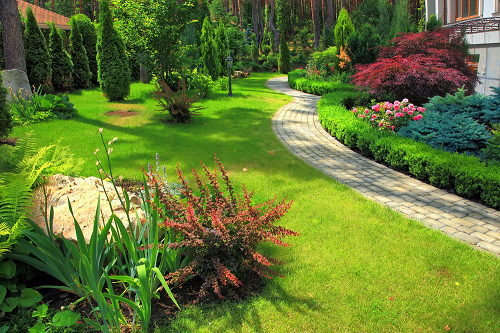Posts Tagged garden maintenance
Transform Your Garden into a Paradise: Tips from KD Landscaping

Creating a garden that feels like a slice of paradise is a rewarding journey, one that enriches both your home and wellbeing. It’s about crafting a space that speaks to your soul, offering a retreat from the hustle and bustle of everyday life. Whether you have a sprawling lawn or a modest balcony, transforming your garden into a personal Eden is achievable with a blend of creativity, planning, and a touch of nature’s magic.
Envision Your Paradise
Begin by envisioning what paradise means to you. Is it a serene Zen garden, a vibrant floral oasis, or a cozy nook brimming with greenery? Consider your space, climate, and the amount of time you can dedicate to garden maintenance. Crafting a mood board can help solidify your vision, combining elements like plants, colors, and themes that resonate with your concept of paradise.
Select a Theme
Your garden’s theme is its heartbeat. It could be centered around a color scheme, such as pastel blooms or lush greens, or a more tangible concept like a butterfly garden, herb haven, or a tropical escape. A theme not only guides your plant and decor selections but also ensures a cohesive aesthetic throughout your space.
Plan Your Plant Palette
Plants are the essence of your garden, bringing your theme to life. Research plants that thrive in your climate and suit your garden’s light conditions. Mix textures, heights, and colors for a dynamic look. Remember to consider blooming periods to ensure your garden remains vibrant through the seasons. Don’t forget about foliage; sometimes, the most tranquil gardens are those lush with varied shades of green.
Incorporate Water Features
The gentle sound of water can transform your garden into a tranquil paradise. Consider adding a small fountain, a bird bath, or even a miniature pond. Water features attract wildlife and create a serene atmosphere, making your garden a true escape from the outside world.
Design Pathways and Seating Areas
Pathways not only add structure to your garden but also invite exploration. Use natural materials like stone or wood to blend with the landscape. Introduce seating areas where you can relax and enjoy the beauty of your surroundings. A well-placed bench, a hammock, or a gazebo can become a focal point of your garden paradise.
Lighting and Decor
Soft lighting can make your garden enchanting by night. Solar-powered lights, lanterns, or string lights can illuminate paths and highlight key features. Decorate with items that enhance your theme, such as statues, wind chimes, or decorative stones. Remember, less is often more; choose pieces that complement the natural beauty of your space.
Maintain and Evolve
A paradise garden is ever-evolving. Regular maintenance is key to ensuring your garden remains a sanctuary. As your garden grows, you may discover new inspirations or learn more about your plants’ needs. Embrace these changes, as they are part of the joy of gardening.
Transforming your garden into a paradise is a journey of love and creativity. It’s about crafting a space that reflects your idea of beauty and tranquility. With thoughtful planning and a touch of nature’s magic, your garden can become a cherished escape, a place where both you and nature thrive in harmony.
The Ultimate Guide to Year-Round Yard Cleanup and Maintenance

Maintaining a beautiful yard is a year-long commitment that requires careful planning and execution. With each season comes a new set of challenges and opportunities to enhance your outdoor space. This comprehensive guide will walk you through the essentials of year-round yard cleanup and maintenance, ensuring your garden thrives in harmony with the changing seasons.
Spring Awakening
As spring unfurls its fresh canvas, the awakening of your garden heralds a season of rebirth and rejuvenation. This period is pivotal for setting the tone for a flourishing garden throughout the year. Begin with a thorough cleanup, removing winter’s remnants—such as fallen branches, leaves, and other debris—to clear the way for new growth. Pruning plays a crucial role in spring; it not only shapes your plants but also promotes healthy development and blossoming. However, it’s essential to know which plants benefit from spring pruning, as timing can affect flowering and growth.
Aeration is another vital task; it alleviates soil compaction, allowing air, water, and nutrients to penetrate the grass roots, laying the groundwork for a vigorous lawn. Early spring is also the ideal time to rejuvenate your garden beds, preparing them for the season’s planting. Incorporating organic matter or compost improves soil health, providing a nutrient-rich environment for plants to thrive.
As new life sprouts in your garden, consider the layout and plan for seasonal additions. Early spring is an opportune moment to plant hardy annuals and perennials, which will establish themselves quickly in the cool, moist soil, ensuring a vibrant display as the seasons progress. By embracing these springtime rituals, you cultivate not just a garden but a sanctuary that grows in beauty and vitality with each passing year.
Summer Vigilance
In the height of summer, your garden enters a phase of intense growth and vitality, necessitating vigilant care to sustain its beauty and health. This period requires a proactive approach to weed management. Regularly removing weeds prevents them from competing with your plants for essential nutrients and water. Mulching becomes an indispensable ally, serving a dual purpose: it conserves soil moisture, crucial during the sweltering days, and acts as a natural barrier against the emergence of unwanted weeds.
Efficient water management is key during this time. Checking and adjusting your irrigation system ensures that your garden receives the right amount of water without waste, a critical consideration during times of potential drought. Adjusting watering schedules to the cooler parts of the day minimizes evaporation and maximizes the water’s benefit to your plants.
Mowing practices should adapt to the summer conditions as well. Keeping the grass at a slightly longer length than usual helps to protect the roots from the intense sun and heat, promoting a healthier, more resilient lawn. This approach not only enhances the green lushness of your garden but also supports its overall ecosystem, encouraging a balance between beauty and sustainability as the season unfolds.
Autumn Preparation
As autumn paints the landscape in vibrant hues, it’s a signal to start preparing your garden for the impending cold. This season is crucial for maintenance tasks that protect and invigorate your garden’s future growth. Raking and removing fallen leaves are essential to avoid mold and fungus, which thrive under damp, decomposing foliage. Autumn’s cool weather is also ideal for overseeding and fertilizing your lawn, setting the stage for robust, green growth when spring arrives.
Planting bulbs during this time promises the reward of early blooms, offering a burst of color at winter’s end. Additionally, autumn is when you should begin winterizing tasks, such as protecting sensitive plants from frost and preparing irrigation systems for the freeze, ensuring they remain functional for the next growing season. This proactive approach not only preserves your garden’s beauty and health through the winter but also lays the groundwork for a flourishing landscape in the year ahead.
Winter Care
Winter’s quiet might suggest a pause in garden activity, but it’s actually a critical period for protective measures and forward planning. Wrapping plants in burlap or frost cloths shields them from the harshest winter elements, preserving your garden’s vitality. This dormant season offers a valuable opportunity for reflection and strategy: assess the past year’s successes and areas for improvement. It’s a perfect time to dream up new garden layouts or consider different plant varieties that could enhance your garden’s diversity and resilience. Planning during these colder months ensures that you’re ready to spring into action when the weather warms, with a clear vision for your garden’s future.
5 Important Considerations When Selecting a Garden Service Expert
Maintaining a healthy and lush garden takes more than just planting and occasional irrigation. You must be willing to invest your time and effort in its maintenance. Nonetheless, as much as you want to see your garden thrive, your busy schedule may not allow you to spend enough time on it.

Hiring garden service experts is the best decision you can make to improve your garden’s appeal and ensure that it is continuously maintained. The garden service providers are highly experienced, and besides taking care of your landscape, they will advise you on the best native plants and the right weed and pest control methods. They help you save time and have peace of mind as you focus on other tasks.
However, to enjoy the benefits of hiring garden service professionals, you must entrust the job to the right providers. How do you establish if the gardeners are reliable? Here are the top guiding tips for you.
Consider the Experience
For how long have the garden service providers been in the industry? The longer they have been offering gardening services, the higher the chances that they are experienced and will meet your needs. The professional gardeners should be willing to provide you with their portfolio to prove the success rate of their previous projects. Check if their clients were satisfied with the services they got. If they were, there is a likelihood that the gardeners will meet your expectations.
Gardening Qualifications
The garden service experts should be qualified for the job. Nonetheless, you cannot gauge their qualification by merely looking at a piece of paper. Gardening involves a lot of physical work and use of tools, and you must ensure that whoever you hire for the job understands how each of the tools works. The gardener should be qualified in a range of services including mowing, feeding and fertilizing, pruning, seeding, weeding, and pest control to mention a few. With this, you only need to hire one company for all the services rather than different contractors for varying tasks.
Are the Providers Certified to Offer Gardening Services?
The garden service professional should be licensed and approved to offer landscaping services. If they are certified, it shows that they meet all the requirements of your local authorities and have been cleared to provide the services. Also, if something goes wrong while at your property or they fail to meet the agreed requirements, you can easily report them to the authorities. The gardening experts should have the license at hand to prove this. You shouldn’t take their word of mouth for it.
Pricing
Cost plays a significant role when searching for any service provider, and this case is not an exception. The gardener should be willing to offer you a comprehensive quote including all the services to expect so you can establish if they are worth the cost. Nonetheless, it would help if you did not let the urge to save money mislead you to select the wrong garden service provider. In most cases, a low price is associated with poor quality services. It would be better if you paid more for excellent garden maintenance rather than paying less only for the gardener to damage your landscape.
Check the Reputation Garden Service Provider
You can determine the gardener’s reputation by asking around from friends, colleagues and relatives and let them express their opinion on the quality of services they got from the company. You may also check online reviews on their website. If you find more positive reviews than the negatives, the chances are that they will meet your needs.
Final Thoughts
Selecting the right garden service provider can be daunting, especially with so many landscaping companies in the market. With the tips above, you will undoubtedly find a qualified gardener to meet both your needs and budget. We are your go-to garden service experts, and you can trust that we will not rest until your garden is transformed to your liking. Contact us today to get a quote and more information on what we do.
Tips and Ideas for a Xeriscape Santa Rosa Project
The movement to xeriscaping has taken hold of arid regions in the United States. With the seldom rains and insufficient water in these areas, maintaining an attractive and healthy lawn is not easy. Xeriscaping provides for a viable alternative for conventional landscaping where non-native plants are introduced to your backyard. These are often slow-growing and drought-tolerant providing you with a hearty and simple environment even in the most stringent climates.
Why Convert to Xeriscape?

Converting to xeriscaping is understandably a big decision for any homeowner. But given the benefits, you should probably consider making this very desired landscape change. Benefits of xeriscaping include:
- Preserving water quality
Xeriscaping requires fewer inputs which in turn reduces the number of chemicals that reach underground water reservoirs. Additionally, the plants that replace the traditional lawn grasses mirror the agroecosystem which act as sufficient filters for groundwater.
- Saves water
Landscaping water requirements have been a thorny issue. For traditional landscaping plants to survive, they require what could be considered excessive irrigation. Note that when done right and properly maintained, xeriscaping has been proven to use just half of the water used on the traditional landscape.
- Low maintenance
Compared to traditional landscaping, xeriscaping boosts of being low maintenance. It eliminates the need for recurrent pruning, tending, mowing, and fertilizing. The plants introduced are often indigenous to the region’s climate and as such little human intervention is required. Still, you should understand that xeriscaping in Santa Rosa requires some grounds keeping.
- Conserves the environment
Grass clippings from conventional landscaping end up in waste landfills. When you convert to xeriscaping, you eliminate the need for mowing and scalping which significantly reduces the waste output. Besides, traditional lawns are usually heavy water users and require inputs that might harm the biodiversity of your lawn.
- Decreases noise pollution
Nothing ruins a silent atmosphere than the loud noise of lawnmowers. Fortunately, when you get into xeriscaping you eliminate the need for mowing. Besides, you can landscape for noise cancellation. This can be done by including deciduous trees and shrubs which are then planted on the edge of your yard.
Tips for a Xeriscape Santa Rosa Project
As you consider xeriscaping, you should probably keep in mind that you should start small. You can go with a zone along your driveway where you could start with perennial shrubs. This small zone should be indicative of the amount of water and finances you might need as you undertake the rest of your yard.
Additional tips include:
- Clump and Scatter Gardening
Arid and semi-arid areas often have to deal with having insufficient rain. In response, these areas are often devoid of cover crops which means that the topsoil is often eroded. As a consequence, the garden soil is often infertile which discourages any gardening you embark on. As a pro tip for your xeriscaping, consider scatter gardening. The ground is then less exposed to the sun which preserves soil moisture eliminating the need for more watering.
- Monochrome Rock Gardening
The monochrome rock garden design is a favorite for xeriscaping beginners. You get to landscape your space with your favorite color, shades, and textures. You should consider having a single-color theme throughout which result in blissful harmony. Curve pathways with your favorite shades that verdant the space. You can also utilize irregular forms of bushes which create a visual interest in your yard.
- Use rows
To incorporate rows into your xeriscaping, consider having the tallest plants at the very back of the yard. In between these, include grasses and flowering shrubs which bring color to the overall design. These work as cover crops ensuring that the spaces in between the rows do not get direct exposure to the sun hence further conservation.
- Rock Garden
If your yard has slopes or terraces, consider clumping your succulents instead of putting them in lines. To ensure the maximization of the water used, place the plants that require the most water at the bottom of the clump. You can arrange these in a design that shows off their color or texture.
- Improve soil quality
You should incorporate mulching and compositing to build your soil’s organic matter. This should include diversifying the plants incorporated in your yard. Additionally, utilize soil amendments whose environmental footprint is negligible.
- Appropriate landscape maintenance
To keep your landscape flourishing, you should efficiently clip overgrowth as you would with traditional landscaping. This timely pruning ensures that your lawn has continuous growth throughout the seasons. Additionally, keep weeds under control by consistently tending to the new growth. You should also consider light top dressing with suitable fertilizer or manure.
- Pre-determine your xeriscaping goals
The universal xeriscaping goal is maintaining a beautiful, healthy lawn while effectively using water. However, you must establish and maintain a personal goal for this endeavor. This could be eliminating the need for consistent maintenance or accomplishing a different look in your yard.
Decide to go with a xeriscape Santa Rosa project and introduce color, beauty, and function to your yard even when you are in desert-like conditions. At best, it is common-sense landscaping that requires good planning and efficient use of water. By incorporating the aforementioned tips, it ensures that you successfully convert to a beautiful lawn that has minimal maintenance and longevity. Contact us for more information.





